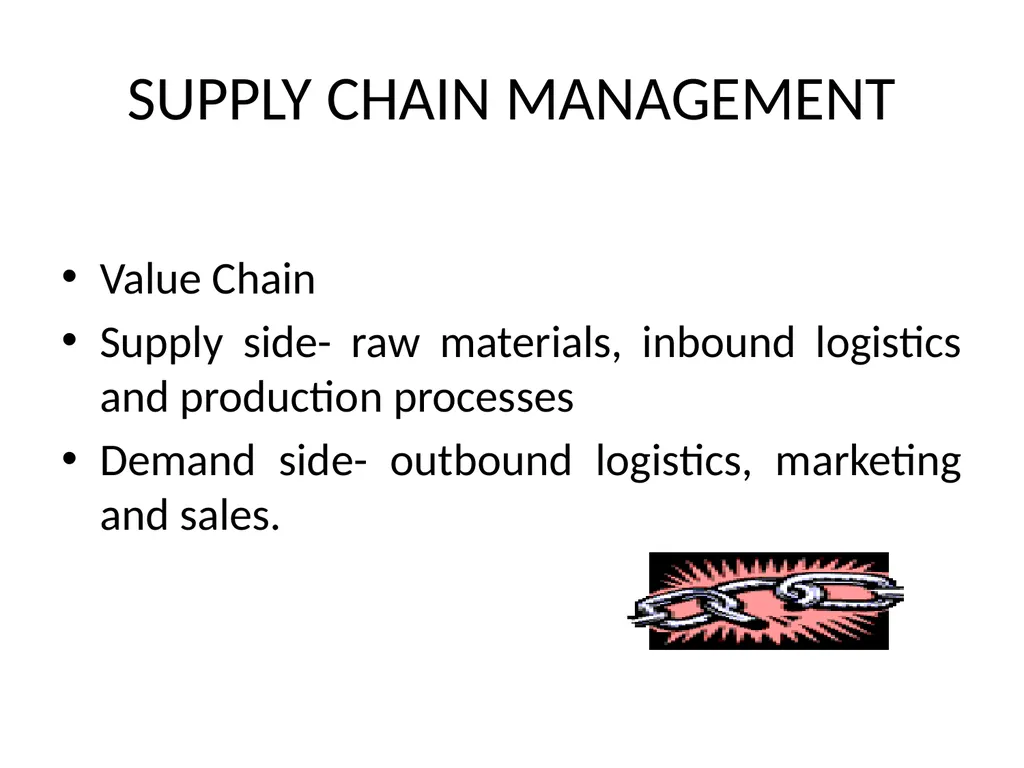SUPPLY CHAIN MANAGEMENT Value Chain Supply side-
Author : calandra-battersby | Published Date : 2025-05-22
Description: SUPPLY CHAIN MANAGEMENT Value Chain Supply side raw materials inbound logistics and production processes Demand side outbound logistics marketing and sales WHAT IS SUPPLY CHAIN MANAGEMENT Leads to Business Process Integration Supply
Presentation Embed Code
Download Presentation
Download
Presentation The PPT/PDF document
"SUPPLY CHAIN MANAGEMENT Value Chain Supply side-" is the property of its rightful owner.
Permission is granted to download and print the materials on this website for personal, non-commercial use only,
and to display it on your personal computer provided you do not modify the materials and that you retain all
copyright notices contained in the materials. By downloading content from our website, you accept the terms of
this agreement.
Transcript:SUPPLY CHAIN MANAGEMENT Value Chain Supply side-:
SUPPLY CHAIN MANAGEMENT Value Chain Supply side- raw materials, inbound logistics and production processes Demand side- outbound logistics, marketing and sales. WHAT IS SUPPLY CHAIN MANAGEMENT Leads to Business Process Integration Supply chain is the system by which organizations source, make and deliver their products or services according to market demand. Supply chain management operations and decisions are ultimately triggered by demand signals at the ultimate consumer level. Supply chain as defined by experienced practitioners extends from suppliers’ suppliers to customers’ customers. SUPPLY CHAIN INCLUDES : MATERIAL FLOWS INFORMATION FLOWS FINANCIAL FLOWS SUPPLY CHAIN MANAGEMENT IS FACILITATED BY : PROCESSES STRUCTURE TECHNOLOGY Supply chain serves two functions: Physical Market mediation Supply chain objectives may differ from situation to situation. For functional products, cost efficiency is the critical factor. For innovative products, responsiveness is the important factor. Leanness + Agility together make up Leagility Supply Chain Structure Supply Chain and Demand Chain Demand chain is defined as the system by which organizations manage sales and distribution of products and services to end users. Conceptually incorrect to look at demand chain separately Look at the pipe as a whole. But is there a pipe at all? More a network Not necessarily linear Value chain orchestration rather than controlling the flow through the pipe A network of independent and interdependent organizations mutually and cooperatively working together to control, manage and improve the flow of materials and information from suppliers to end users SUPPLY CHAIN DRIVERS Not new. Value system of Michael Porter Why sudden interest? Demanding customers Shrinking product life cycles Proliferating product offerings Growing retailer power in some cases Doctrine of core competency Emergence of specialized logistics providers Globalization Information technology SUPPLY CHAIN ELEMENTS Supply Chain Goals Efficient supply chain management must result in tangible business improvements. It is characterized by a sharp focus on Revenue growth Better asset utilization Cost reduction. Reduce Overall Cycle Time : Improve Response Supply Chain Management Underlying Principles Compression Conformance Co-operation Communication (Planning/Manufacturing/Supply) (Forecasts/Plans/Distribution) (Cross -Functional) (Real Time Data) C Changing Paradigm Functional vs Process Products vs Customers Revenues vs Performance Inventory vs Information Transactions vs Relationships Critical Success Factors today Cross functional management and planning skills Ability to define, measure and manage service requirements by market segment Information systems Relationship management and win win orientation PUTTING IN PLACE A WELL OILED SUPPLY CHAIN Supply chain as an efficient customer satisfying process Effectiveness of the whole














